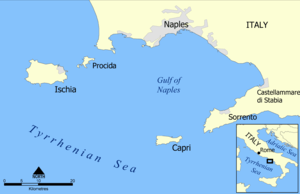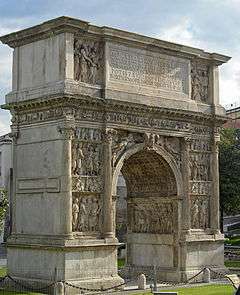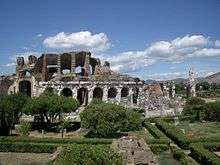Baiae


Baiae, known in modern Italian as Baia, was a mineral springs and coastal resort on the northwest shore of the Gulf of Naples in ancient Italy. It was fashionable for centuries during antiquity, particularly towards the end of the Roman Republic, when it was reckoned as superior to Pompeii, Herculaneum, and Capri for the super-rich. It was notorious for its hedonistic offerings and the attendant rumors of corruption and scandal. It later formed part of Port Julius, the base of the western fleet of the Imperial Roman Navy. It was deserted and its ruins largely submerged by local volcanic activity by the time of the Renaissance. What is left of Baia is now a frazione of the comune of Bacoli in the Campania region of Italy.
Name
Baiae was said to have been named after Baius (Greek: Βαῖος, Baîos), the helmsman of Odysseus's ship in Homer's Odyssey, who was supposedly buried nearby.[1] The adjacent "Baian Gulf" (Latin: Sinus Baianus) was named after the town. It now forms the western part of the Gulf of Pozzuoli.[1]
The settlement was also mentioned in 178 BC under the name Aquae Cumanae ("Cumaean Waters").[2]
History
Baiae was built on the Cumaean Peninsula in the Phlegraean Fields, an active volcanic area. It perhaps originally developed as the port for Cumae. The bathhouses of Baiae were filled with warm mineral water directed to its pools from underground sulfur springs. Roman engineers were also able to construct a complex system of chambers that channeled underground heat into facilities that acted as saunas. In addition to their recreational function, the baths were used in Roman medicine to treat various illnesses and physicians would attend their patients at the springs.[3]
Baiae was particularly fashionable towards the end of the Roman Republic. Marius, Lucullus, and Pompey all frequented it.[4] Julius Caesar had a villa there, and much of the town became imperial property under Augustus. With its large swimming pools and domed casino, it continued to be a getaway for the elite. Nero had a notable villa constructed in the middle of the 1st century and Hadrian died at his in AD 138. It was also a favorite spot of the emperor Septimius Severus.[4] The resorts sometimes capitalized on their imperial associations: Suetonius mentions in his history that the cloak, brooch, and gold bulla given to the young Tiberius by Pompey's daughter Pompeia Magna were still on display around AD 120.
According to Suetonius, in AD 39, Baiae was the location for a stunt by the eccentric emperor Caligula to answer the astrologer Thrasyllus's prediction that he had "no more chance of becoming emperor than of riding a horse across the Gulf of Baiae". Caligula ordered a 3-mile-long pontoon bridge to be built from impounded ships of the area, fastened together and weighted with sand, stretching from Baiae to the neighboring port of Puteoli. Clad in a gold cloak, he then crossed it upon a horse.[5] Cassius Dio's Roman History also includes the event, with the detail that the emperor ordered resting places and lodging rooms with potable water erected at intervals along the bridge.[6] As late as the 18th century, scattered fragments were still being shown to tourists as the "Bridge of Caligula".[7] Malloch has argued that Suetonius's account was likely colored by his bias against Caligula; instead, he claims that “the act of bridging the Bay of Naples was an excellent—and safe—means by which to lay the foundation for [Caligula’s] military glory.”[8]
Baiae was notorious for the hedonistic lifestyle of its residents and guests. In 56 BC, the prominent socialite Clodia was condemned by the defense at the trial of Marcus Caelius Rufus as living as a harlot in Rome and at the "crowded resort of Baiae", indulging in beach parties and long drinking sessions. An elegy by Sextus Propertius written in the Augustan Age describes it as a "den of licentiousness and vice". In the 1st century, "Baiae and Vice" formed one of the moral epistles written by Seneca the Younger; he described it as a "vortex of luxury" and a "harbor of vice".
It never attained municipal status, being administered throughout by nearby Cumae.[4] Under the later Roman Empire, Baiae also formed part of Port Julius, the base of the western fleet of the Roman Navy.
Baiae was sacked during the barbarian invasions[4] and again by Muslim raiders in the 8th century. It was deserted owing to recurrent malaria by 1500, but Pietro di Toledo erected a castle, Castello di Baja, in the 16th century.[4]
Because the coast subsided, largely due to local volcanic activity, most of Baiae is now under water in the Bay of Naples.[4]
The site has occasionally revealed Roman sculptures. The Aphrodite of Baiae, a variant of the Venus de Medici, was supposedly excavated there sometime before 1803, when the English antiquary Thomas Hope began displaying it in his gallery on Duchess Street in London.[9] A cache of plaster casts of Hellenistic sculptures was discovered in the cellar of the Baths of Sosandra at Baiae; they are now displayed at the town's archaeological museum.[10] The collection includes parts of several famous sculptures, including Athens's Harmodius and Aristogeiton and the Athena of Velletri. It suggests that the area had a workshop mass-producing marble or bronze copies of Greek art for the Italian market.[11]
Ruins
The most remarkable ruins are those colloquially known as the Temple of Mercury, the Temple of Venus, and the Temple of Diana, which were traditionally credited to some of the more famous residents of the towns' villas.[4]
The town's misnamed "Temple of Mercury"[12] is now known as the Temple of Echo, after the acoustical properties of its 21.5 m (71 ft) diameter dome, the largest in the world prior to the construction of Rome's Pantheon in AD 128.[13][14]
Some of the items excavated on site are preserved at the town's archaeological museum, the Museo Archeologico dei Campi Flegrei (Phlegraean Fields Archaeological Museum).
In culture
- The lost wonders of Baiae were a common feature of Romantic poetry. It appears in John Keats's "Ode to May" and in the third stanza of Shelley's "Ode to the West Wind". The vanished columns of the ancient town inundated by the sea is the central conceit of Konstantin Batyushkov's 1819 "You awake, oh Bayya, from the tomb..." (Ты пробуждаешься, о Байя, из гробницы...), "one of his last and finest poems"[15]
- The "princely" seaside resort of the empire appears in J. Meade Falkner's 1895 novel The Lost Stradivarius and Anatole France's 1902 "Procurator of Judea" (Le Procurateur de Judée). In current fiction, it is the setting of Caroline Lawrence's Sirens of Surrentum; John Maddox Roberts's Under the Shadow of Vesuvius; Steven Saylor's 1992 Arms of Nemesis, set during the Spartacus Rebellion; and Marguerite Yourcenar's Memoirs of Hadrian.
- In the Ecce Romani series of Latin textbooks, Baiae is the location of the character Gaius Cornelius Calvus's summer villa.
See also
References
Citations
- 1 2 EB (1911).
- ↑ EBO (2007).
- ↑ Yegül (1996).
- 1 2 3 4 5 6 7 EB (1878).
- ↑ Suet., "Caius Caesar Caligula", 12 Caes..
- ↑ Cassius Dio, Rom. Hist., Bk LIX.
- ↑ Holland, Elizabeth, Journal, p. 23.
- ↑ Malloch, Simon J.V. (2001), "Gaius' Bridge at Baiae and Alexander-Imitatio", The Classical Quarterly, Vol. 51, No. 1, pp. 206–217.
- ↑ Waywell & al. (1986), p. 41 & fig. 11.
- ↑ "Corpus Vasorum Antiquorum", CVA Online.
- ↑ "B216", Beazley Archive.
- ↑ "The thermo-mineral complex at Baiae and De Balneis Puteolanis", Access My Library.
- ↑ Mark & al. (1986), p. 24.
- ↑ "The Ancient Baths of Baiae", Tour Italy.
- ↑ Altshuller (1992), p. 127.
Bibliography
- "Baiæ", Encyclopædia Britannica, 9th ed., Vol. III, New York: Charles Scribner's Sons, 1878, p. 240.
- "Baiae", Encyclopædia Britannica, 11th ed., Vol. III, Cambridge: Cambridge University Press, 1911, p. 214.
- "Baiae", Encyclopædia Britannica Online, 2007.
- Altshuller, Mark (1992), "The Transition to the Modern Age: Sentimentalism and Preromanticism, 1790–1820", The Cambridge History of Russian Literature, rev. ed., Cambridge University Press, ISBN 0521425670.
- Mark, R.; et al. (March 1986), "On the Structure of the Roman Pantheon", Art Bulletin, Vol. 68.
- Waywell, Geoffrey B.; et al. (1986), The Lever and Hope Sculptures: Ancient Sculptures in the Lady Lever Art Gallery, Port Sunlight, and a Catalogue of the Ancient Sculptures Formerly in the Hope Collection, London and Deepdene.
- Yegül, Fikret K. (1996), "The Thermo-Mineral Complex at Baiae and De Balneis Puteolanis", The Art Bulletin, Vol. 78, No. 1, pp. 137–161.
Coordinates: 40°49′00″N 14°04′11″E / 40.81667°N 14.06972°E


